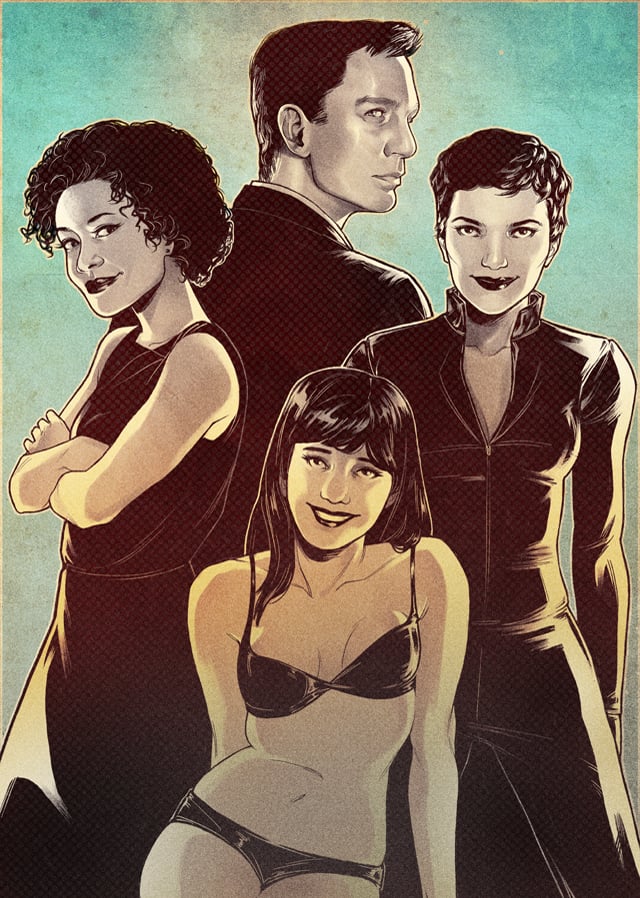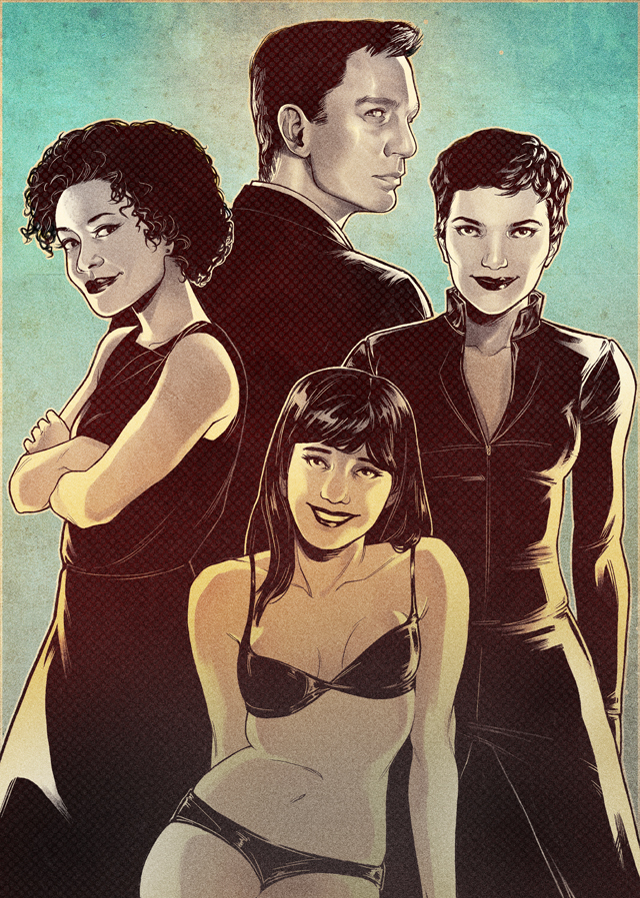
Original illustration by Emilie Majarian for The Mary Sue.
Welcome to Bond Girl, a new series where we’ll be re-watching and re-evaluating every James Bond film until Spectre’s release. Check out previous entries here.
Content warnings for racism, stereotypes, brief mention of a rape threat.
For the most part, I was prepared to have a very unhappy reaction towards Live And Let Die, and at least I can say that I got what I expected.
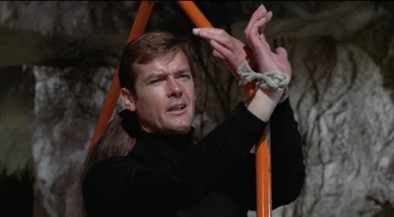
It’s not just James Bond I’m having issues with this time. It’s the fact that the genres don’t mesh; the British spy and Blaxploitation genres probably shouldn’t have ever been in the same room together. It’s the fact that, aside from one or two characters, every Black person in Live And Let Die was on the side of evil. It’s the fact that multiple West Indian and Caribbean religions and cultures were misused during this film.
The film, eighth in the franchise and the third to be directed by Guy Hamilton, is a glossy, gritty work that looks amazing but has some serious issues. Shifting away from the usual plots of supervillains trying to take over the world, Live And Let Die focuses on James Bond’s attempts to stop a Harlem drug lord from distributing two tons of heroin after the man kills several MI6 agents and draws attention to himself.
Objectively, if I look at it from a sort of outsider POV, this movie is stylistically interesting. It’s flashy and actually fun. After all, this is a James Bond film, and style is one thing that they have in spades. But style isn’t everything.
The positive parts of the film (the lush landscapes, the fight scenes, and Roger Moore’s first showing as James Bond) don’t erase the negative parts, such as the stereotyping of Black people, the co-opting and misappropriation of diasporic religions and cultures, and the ridiculous preoccupation with virginity and women’s sexuality.
One of the most obvious issues that Live And Let Die has is that it falls into that weird pattern where it’s simultaneously more and less racist than I was expecting. Of course, it would’ve had major race issues in its original novel form – Fleming was not known for being the most open-minded about race – but the film’s reliance on the Blaxploitation genre and its stereotypes about Black people kicks it up a notch. I’m a bit hit or miss on the genre.
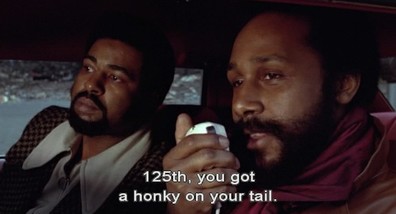
Blaxploitation films were never really my thing. Despite the fact that they were technically supposed to be made for black audiences, they tended to focus on stereotypes about Blackness and black people. These sorts of movies heralded under the banner of Blaxploitation were definitely seen as a form of empowerment for Black audiences due to the freedom shown by the characters; but to me, that doesn’t feel right. To this day, they feel like movies made based on what film studios thought black audiences would like or what they were like, rather than true looks at the lives of black people.
As a whole, the exploitation genres leave me with a bad taste in my mouth because usually, whatever they’re exploiting to get viewers usually isn’t handled very well. Live And Let Die takes the typical Blaxploitation themes and tropes and applies them (rather ham-fistedly, I think) to the James Bond franchise.
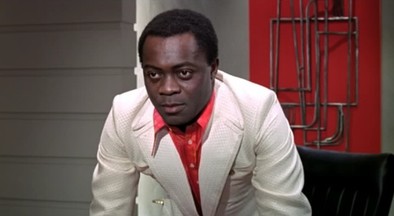
Sure, this movie is one of the most racially diverse in the franchise so far, but seeing characters/actors of color in stereotypical roles kind of lessens the impact. At first, I was excited about how many Black people were in the film (in the same way I was while watching You Only Live Twice and seeing Japanese people actually playing Japanese characters); but as the film went on, I realized that I was mainly getting images of stereotypes.
Set in Harlem, New Orleans, and a fictional Caribbean country, the movie has a large amount of characters from the African diaspora. Unfortunately, most of those characters are working to oppose Bond. Offhand, of the characters of color that have speaking roles in the film, only two are definite good guys. All of the other black characters? Bad guys or double agents working for our big bad villain, Kananga.
The way that it’s framed in the film is annoying. With all but a few black characters working for the film’s main villain and working against James Bond, it’s framed as a world where black people aren’t on the side of good. Sure, it’s just a movie and not a news report or anything. I know that the Eon Production people didn’t necessarily intend to create an “us versus them” situation that pitted James Bond up against opponents that are largely black but hey. That’s what this movie feels like to me.
Now there are a few good moments and characters that don’t feel like stereotypes. Quarrel Jr. – son of the Quarrel that appeared in Dr. No as James Bond’s ally and dies in the swamps – shows up during the scenes at San Monique and follows in his father’s footsteps. Then there’s Lon Satton playing Harold Sutton, a CIA agent in Harlem who shows up in one scene only.
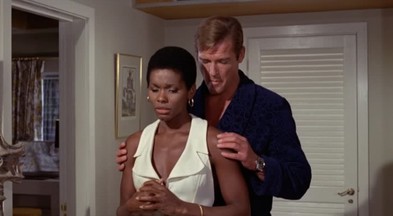
All of the other black characters – Including Gloria Hendry’s Rosie Carver, who meets an unfortunate end – kind of exist to get in Bond’s way. Because of the way that even one-off background characters are portrayed as being part of Kananga’s web (either willing or unwilling), there’s a sense that we’re supposed to sympathize with Bond for being placed up against these people.
This whole movie is weird to me, because this isn’t what Blaxploitation films are supposed to be like. Having James Bond as the hero while making nearly every single black character his enemy kind of makes moot one major recurring theme in the genre: that the black characters the audience is identifying with are morally complex and likely to be heroes or anti-heroes. Live And Let Die pulls heavily from the Blaxploitation genre, but twists it to be favorable to a hero atypical to the genre.
I don’t like the genre’s themes, but I understand why other people both from the past and in the present would see it as empowering. So to watch this movie and realize that it’s essentially taken the teeth from Blaxploitation films to pad Fleming’s original story is just unpleasant.
In keeping with my focus on the film’s race issues, next I really want to talk about the way that West Indian/Caribbean mythology is used in the narrative. Mainly, the use of obeah and voodoo is kind of… wrong.

Both religions (practiced primarily by members of the African diaspora in the Caribbean) are framed as mysterious and pretty awful. Recurring themes of voodoo in Live And Let Die are of human sacrifice (especially that of white people at the hands of black islanders) and the Baron Samedi as a menacing mysterious figure that is also somewhat of a fool. The gist of it is that they set up voodoo as something to be feared, and as a tool to be used to strike at Bond. It’s one of the most frustrating things to me, how to this day the idea of voodoo in mainstream culture tends to look at it in fearsome ways. It’s been over forty years since this movie came out and still this is the most common perception of a religion that actual people practice.
Same thing goes for the use of obeah in the plot. I’m more familiar with obeah than I am voodoo because of the link that West Indian culture – my culture – has to it. There are obeah women on the island I’m from, along with a storied history of magic in our mythology and folktales. So whenever I think about the use of obeah in this movie, I start to get excited about something that reminded me of stories I heard as a child.
Sadly, Jane Seymour’s Solitaire is the closest thing to an obeah woman in the film and well… that’s not a good thing for several reasons. First of all, obeah women are primarily Caribbean women who are the descendants of enslaved African and Caribbean people, so you have the erasure of existence. Next, her powers don’t actually make sense; well, not her ability to see the future, but her use of tarot cards to do it. That’s just not how that works. It bugged me how obvious it was that very little care and research went into making sure that the religious aspect of these cultures were accurate.
To me, the scenes that revolved around the two religions were in turns inaccurate, disrespectful, and hard for me to enjoy watching. I think that the only thing that really does help me kind of put away my frustration with the scenes is that if I read Fleming’s corresponding novel from cover to cover, that I’d probably be complaining for days.
Lastly for the negative parts, I want to bring up something that I’ve always actually hated about this movie. Even more than the weird stereotyping, I can’t stand the way that the film treats Solitaire’s powers in relation to her virginity. How messed up is it that Solitaire’s powers stop working when she has sex for the first time? Not only are we told – by Solitaire and Kananga both – that Solitaire’s gift will stop working if she ever has sex, but at least once, Kananga actually threatens to rape her.
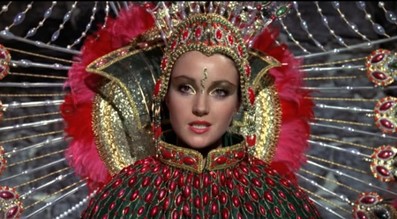
Not only is her character bogged down in purity myths and whatnot, but she is explicitly punished in the narrative for having sex with James Bond. What else can you call it? Immediately after the scene where Bond is implied to take Solitaire to bed, she confesses that she’s lost her powers. There’s no other correlation that we can make: the narrative punishes her for this. First she loses her powers, then she winds up being threatened by Kananga. Solitaire gets a happy ending at the end of the film, of course, but it doesn’t erase the fact that she doesn’t have a lot of agency throughout the film, and that when she does express herself and do what she wants, she winds up shamed and punished for it. Great message, right?
Now, Live And Let Die wasn’t all rage and frustrated tweeting for me. There were parts of it that I liked, and even some that I loved. The main thing I liked about this movie was how I really felt as if Roger Moore is a really good James Bond. He’s different from Sean Connery in this movie, more empathetic. Sure, there were times when the old rakish Bond characterization showed up in this film, and I know that there’ll be other times that I’ll see it, but he’s so good in this movie. One of the things I felt about Connery’s Bond was that he didn’t do emotion very well. Anything more serious than a quip or two didn’t always ring true with him. Moore’s Bond (in this film) feels more sincere.
A major point of enjoyment for me in this film was watching Moore’s Bond and just basking in the differences. He’s such a good Bond in this film. Even though quite a few of his quips fell flat for me, I enjoyed watching him onscreen. Moore’s Bond is more accessible, more immediately friendly and funny. Mostly, it’s because funny things happen to him and because this is the first film in his run so I haven’t had time to get tired of him the way I did Connery.
The other things I liked were small. The scenery was gorgeous and very vivid throughout. Returning to Jamaica for the scenes set in the fictional San Monique was a good idea because this was the island that Fleming loved and lived on. It remains to this day one of the most beautiful places in the world. I really can’t think of a better place for the producers to base San Monique on.
I also enjoyed the fight scenes. I mean they’re generally my favorite parts of the films but okay, the ones in this movie were good. So good. I liked that while the stunt coordinators obviously made the effort to make sure that Moore’s fights were similar to Connery’s, the fights still felt different. I especially liked the final scene between Kananga and Bond because it was a bit gross and highly implausible, but it was so different from most of the boss/villain fights that we’ve seen in the franchise so far. I liked it just because of that.
I’m going to be honest: I didn’t really like this film. I like Roger Moore a lot in the movie, but the actual plot is kind of a major miss for me. Coming to terms with the fact that while I like James Bond in the film but hardly anything else kind of frustrates me because for much of this experience with Connery, I was grumpy about both the plot and our favorite super spy.
Here’s hoping that The Man With The Golden Gun gets me back in the groove!
What I’m looking forward to:
Christopher Lee as Scaramanga is one of the best villains in Bond history. I’m the last person to fawn over a fictional villain, but even though I love to hate him, Scaramanga is at the top of my villain list too.
The return of Q who was absent in this film (even though his gadgets weren’t) along with the bumbling Sheriff Pepper who was present in the film. I’m looking forward to seeing Q because he’s one of the best recurring characters in the franchise. Sheriff Pepper might be one of the worst recurring characters but he’s vaguely amusing and I’m trying to figure out why anyone thought to include a bumbling sheriff character in the series.
Stitch writes about comics, nerd history, and ridiculous romance novels when not working frantically on her first collection of short stories. Find her on her blog or on Twitter.
—Please make note of The Mary Sue’s general comment policy.—
Do you follow The Mary Sue on Twitter, Facebook, Tumblr, Pinterest, & Google +?



